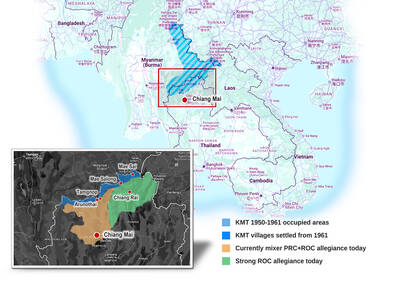Steering clear of labeling it an animal rights film, Man on Wire director James Marsh has returned to the documentary world by examining a chimpanzee famed in the 1970s for being raised like a human.
Project Nim, the British director’s first documentary since his Oscar-winning Man on Wire, premiered at the opening night of the Sundance Film Festival on Thursday to strong audience buzz and solid reviews.
Marsh, who finished editing the film two days before the screening, said Project Nim offered as many lessons about how humans see themselves as it does about chimps.

Photo: REUTERS
“It’s not an animal rights movie; it’s not an activist kind of film,” he said. “It’s an animal life story but in fact, within that there is this great, interesting interaction with human beings and we are learning a bit about ourselves too.”
Comic and touching, Project Nim follows the 1970s research project that made headlines for experimenting with a chimp named Nim, seized as a baby and placed with a human mother in New York City who tried to raise him like her own children.
The film uses extensive video footage that follows Nim as he is raised in nappies, taught sign language and tragically passed through various caretakers. He grows from being an affectionate, mischievous baby to a stronger, cunning adult who eventually meets other chimpanzees with curious results.
“He doesn’t know anything about what he is, he just sees human beings and so the film and indeed, the experiment, becomes about nature and nurture. If you nurture a sentient animal, what and how can you influence him? And the answer is in the film,” Marsh said. “We discover quite quickly that he has his own unique chimpanzee nature.”
“We are studying him [Nim] in the film, and I think he is studying us. There is a lot of quite human drama that unfolds around this chimpanzee,” he said. “His story becomes one of increasing control that we exert upon him and he is baffled and confused, particularly when we start out mothering him.”
The film has been initially well-received by critics, with The Hollywood Reporter saying, “James Marsh again proves himself a storyteller of impeccable craftsmanship and delicacy in the unsettling but equally enthralling Project Nim.”
Variety said the Nim works by “raising big questions about ethics, parenting strategies and what separates man from animal.”
Marsh said he deliberately avoided being funded by animal rights groups because he wanted people to know Nim raised broader ideas such as how language fits into evolution.
“This is about a human, animal drama so it has no overt agenda,” he said. “The film hopefully works as a narrative first and foremost.”

President William Lai (賴清德) yesterday delivered an address marking the first anniversary of his presidency. In the speech, Lai affirmed Taiwan’s global role in technology, trade and security. He announced economic and national security initiatives, and emphasized democratic values and cross-party cooperation. The following is the full text of his speech: Yesterday, outside of Beida Elementary School in New Taipei City’s Sanxia District (三峽), there was a major traffic accident that, sadly, claimed several lives and resulted in multiple injuries. The Executive Yuan immediately formed a task force, and last night I personally visited the victims in hospital. Central government agencies and the

Australia’s ABC last week published a piece on the recall campaign. The article emphasized the divisions in Taiwanese society and blamed the recall for worsening them. It quotes a supporter of the Taiwan People’s Party (TPP) as saying “I’m 43 years old, born and raised here, and I’ve never seen the country this divided in my entire life.” Apparently, as an adult, she slept through the post-election violence in 2000 and 2004 by the Chinese Nationalist Party (KMT), the veiled coup threats by the military when Chen Shui-bian (陳水扁) became president, the 2006 Red Shirt protests against him ginned up by

As with most of northern Thailand’s Chinese Nationalist Party (KMT) settlements, the village of Arunothai was only given a Thai name once the Thai government began in the 1970s to assert control over the border region and initiate a decades-long process of political integration. The village’s original name, bestowed by its Yunnanese founders when they first settled the valley in the late 1960s, was a Chinese name, Dagudi (大谷地), which literally translates as “a place for threshing rice.” At that time, these village founders did not know how permanent their settlement would be. Most of Arunothai’s first generation were soldiers

Among Thailand’s Chinese Nationalist Party (KMT) villages, a certain rivalry exists between Arunothai, the largest of these villages, and Mae Salong, which is currently the most prosperous. Historically, the rivalry stems from a split in KMT military factions in the early 1960s, which divided command and opium territories after Chiang Kai-shek (蔣介石) cut off open support in 1961 due to international pressure (see part two, “The KMT opium lords of the Golden Triangle,” on May 20). But today this rivalry manifests as a different kind of split, with Arunothai leading a pro-China faction and Mae Salong staunchly aligned to Taiwan.